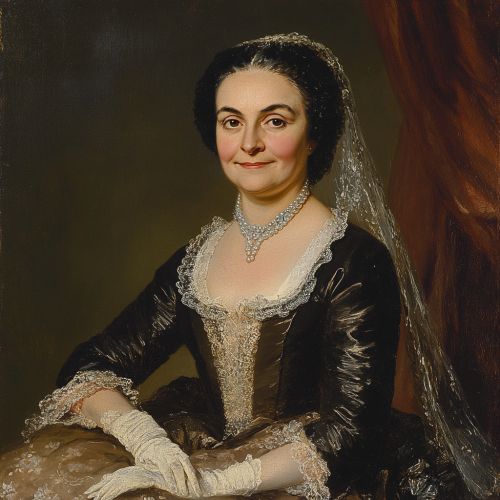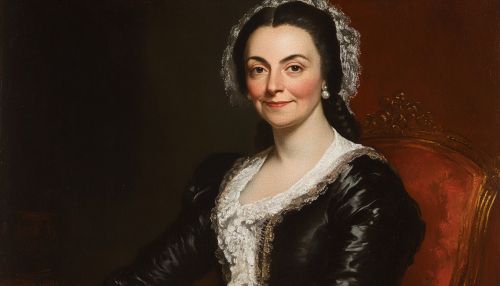Abigail Adams: Difference between revisions
(Created page with "== Early Life and Family Background == Abigail Adams, born Abigail Smith on November 22, 1744, in Weymouth, Massachusetts, was the daughter of William Smith, a Congregational minister, and Elizabeth Quincy Smith. Her family was well-established and held a significant social position in the Massachusetts Bay Colony. Abigail's maternal grandfather, John Quincy, for whom her son was named, was a prominent figure in the colony's political and social cir...") |
No edit summary |
||
| (One intermediate revision by the same user not shown) | |||
| Line 15: | Line 15: | ||
Abigail Adams was not just a supportive spouse; she was also a political advisor to her husband. Her letters reveal her keen understanding of politics and her ability to influence John's decisions. She was a strong advocate for women's education and property rights, believing that women should be more than just domestic caretakers. | Abigail Adams was not just a supportive spouse; she was also a political advisor to her husband. Her letters reveal her keen understanding of politics and her ability to influence John's decisions. She was a strong advocate for women's education and property rights, believing that women should be more than just domestic caretakers. | ||
[[Image:Detail-98139.jpg|thumb|center|Portrait of Abigail Adams in a formal dress, seated, with a calm and composed expression.|class=only_on_mobile]] | |||
[[Image:Detail-98140.jpg|thumb|center|Portrait of Abigail Adams in a formal dress, seated, with a calm and composed expression.|class=only_on_desktop]] | |||
== First Lady of the United States == | == First Lady of the United States == | ||
Latest revision as of 16:44, 8 October 2024
Early Life and Family Background
Abigail Adams, born Abigail Smith on November 22, 1744, in Weymouth, Massachusetts, was the daughter of William Smith, a Congregational minister, and Elizabeth Quincy Smith. Her family was well-established and held a significant social position in the Massachusetts Bay Colony. Abigail's maternal grandfather, John Quincy, for whom her son was named, was a prominent figure in the colony's political and social circles.
Abigail received no formal education, which was typical for women of her time. However, she was an avid reader and was educated at home by her mother and grandmother. Her extensive reading included works by John Milton, William Shakespeare, and other classical authors, which contributed to her intellectual development.
Marriage and Family Life
On October 25, 1764, Abigail married John Adams, a lawyer who would later become the second President of the United States. The couple had six children, including John Quincy Adams, who would also become a U.S. president. Their marriage was characterized by mutual respect and intellectual companionship, and they maintained a prolific correspondence throughout their lives, especially during John's long absences due to his political duties.
Role in the American Revolution
Abigail Adams played a crucial role during the American Revolution. While John Adams was away serving in the Continental Congress, Abigail managed the family farm in Braintree (now Quincy), Massachusetts, and took care of their children. She also provided John with valuable insights and advice through her letters, which have become an essential primary source for historians studying the period.
One of her most famous letters, written in March 1776, urged John to "remember the ladies" when drafting new laws for the fledgling nation. This letter is often cited as an early plea for women's rights in the United States.
Political Influence and Advocacy
Abigail Adams was not just a supportive spouse; she was also a political advisor to her husband. Her letters reveal her keen understanding of politics and her ability to influence John's decisions. She was a strong advocate for women's education and property rights, believing that women should be more than just domestic caretakers.


First Lady of the United States
Abigail Adams served as the First Lady of the United States from 1797 to 1801. During this time, she continued to be an influential figure, hosting numerous social events and providing counsel to her husband. Unlike her predecessor, Martha Washington, Abigail took a more active role in political discussions and was not afraid to voice her opinions on various issues.
Later Years and Legacy
After John Adams' presidency, the couple retired to their farm in Quincy, Massachusetts. Abigail continued to manage the household and remained active in her community. She maintained correspondence with many prominent figures of the time, including Thomas Jefferson, despite their political differences.
Abigail Adams passed away on October 28, 1818, at the age of 73. Her legacy endures through her letters, which provide a vivid account of her life and the early years of the United States. She is remembered as a pioneering advocate for women's rights and an influential figure in American history.
See Also
References
- [Primary sources and historical documents related to Abigail Adams' life and correspondence]
